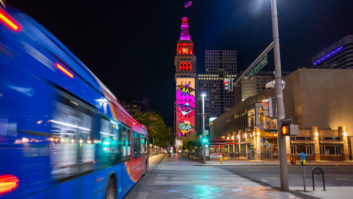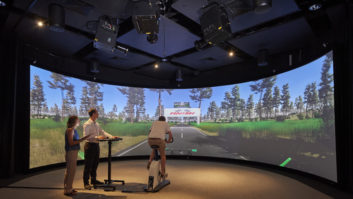
In the first part of this feature we looked at the new opportunities opening up in the projection market, despite the falling sales figures. Here Steve Montgomery reveals the applications where projectors can really have an impact.
Projectors really come into their own on massive projection projects on buildings and other large structures. “There is really no other option to bathe a whole building in light or images than projection. Even LED curtains are only viable for small areas,” says Chris Athanasiou, technical director of AVM Ltd. “Large event display and shows are becoming more creative as designers take advantage of highly powerful projectors and projection mapping technology to light up entire structures.” This, he feels, presents additional opportunities to dealers and system integrators. “These types of installation, whether temporary or permanent, require powerful processing devices behind them, like Christie Spyder, Pandoras Box and Analog Way Ascender/NexTage. In addition there are opportunities to offer installation expertise to meet the complex requirements of these events and create content for them.”
In these examples, too, laser has benefits. The larger installs use multiple projectors to create single images with edge-blending to maintain the colour and brightness image consistency. “Laser projection offers consistent, reliable performance with minimal maintenance requirements. Edge-blending in multi-projector installations is very common nowadays, and the nature of laser projectors means that the colour consistency across individual units is very good. Some models, such as those made by Epson, even have on-board cameras to check the image quality,” explains Stuart Holmes, director of PSCo. “In contrast, lamped projectors can suffer from noticeable changes in brightness and colour performance over the life of the lamp. So for multi-projection installations, if you need to re-lamp one projector, you generally have to do them all. The colour performance and high brightness of laser units provide rich and vivid displays which do not degrade over the lifespan of the unit.”
While the market for projectors is declining at the lower end of the market as a consequence of the rise in flat panel displays, there are still pockets of applications within existing sectors, including education and houses of worship, that continue to use it. New, bright low profile laser-based products are being launched to meet these applications and integrators are still actively promoting and installing them in many applications.
Market consolidation
The market will continue to evolve and more applications will arise as John Dykes, Casio’s business development manager, believes: “There’ll be a consolidation within the market, as some brands will move away from projection while others will specialise further. The infiltration of 4K and higher resolutions has meant the market will move towards higher-resolution displays. The trend is towards more efficient technology, with integral networking and easy to use BYOD connectivity options. Gaming is a big market for projection at the moment, as there has been an increase in gaming rooms both in homes and offices. As the demand for videoconferencing grows, projectors have more of a place in VC meeting rooms and there is a real opportunity for projection to lead the way for multi-purpose meeting spaces for SMEs.”
Product development will continue; enabling projectors to meet the demands of the industry. Holmes concludes: “Laser projection technology is maturing and we can expect to see brighter devices. At the higher end of the range performance will approach that of xenon projectors for use in large auditoriums and commercial cinemas. At the same time, the size of laser projectors will come down, making them an option for schools and smaller installations. Over the next few years, we can expect laser to become the primary light source technology, overtaking traditional UHP lamps in terms of sales volume.”
(Main picture: Kung Fu Panda exhibit at Shrek’s Adventure, London featuring Optoma projection)
Case study: Legendary projector performance

King Arthur’s Labyrinth, in Machynlleth in Wales, is an underground storybook with dramatic scenes from myths and legends. Visitors travel deep into a cave on a boat that passes through a Magical Waterfall and are suddenly surrounded by flames from a dragon. The location is a dusty, damp and cold former slate mine.
An Optoma ZU510T 5,500 lumen laser projector is installed above the river in a heated enclosure, remaining in darkness until automatically triggered by the presence of a boat to project the flames.
Andy Noble, managing director of Piranha AV, says: “We chose the projector for its brightness, resolution and flexibility of mounting orientation. It has an IP5X dust resistance rating and delivers up to 30,000 hours of reliable operation without the need for expensive lamp or filter replacements. It would be a major job to access the projector in its enclosure above the river so we need reliability, longevity and no lamp changes.”
www.avmltd.co.uk
www.casioprojector.com
www.optoma.co.uk
www.piranhaaudiovisual.co.uk
www.psco.co.uk







